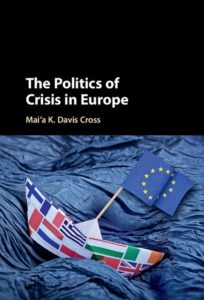

Ten years since the beginning of the Eurozone crisis, we could be forgiven for believing that the European Union is facing an existential crisis. Or more precisely, a triple existential crisis.[1] Recent tensions between the Italian government and the European Commission, a potentially looming recession, and fraught negotiations on the direction of reform efforts provide much to panic about in the Eurozone. The refugee crisis has exposed troubling anti-immigration sentiment across the region and has cast doubt over the Union’s ability to act cohesively. Brexit, at least initially, raised the spectre of European disintegration, and upcoming European elections are predicted to reflect significant gains for Eurosceptic parties in the European Parliament.[2]
The Politics of Crisis in Europe shows that existential crises are really nothing new for the EU. In fact, the European project has been eulogized, like clockwork, every couple of years since the Treaty of Rome. In her excellent, convincing, and counter-intuitive book, Mai’a K. Davis Cross argues that not only has the EU survived repeated existential crises, “it ultimately seems to thrive” on them (219). How can we explain the EU’s ability to not only defy death, but to emerge from ”existential crisis” with a renewed appetite for deepening integration?
Cross contributes two original and important concepts to answer this question. First, the EU is plagued by episodes of what Cross labels “integration panic” – “periods of overblown, existential crisis in which social narratives about events build up the perception that the end of Europe is at hand” (220). What could just as easily be perceived as setbacks are routinely socially constructed as nothing less than “the end of Europe.” Second, Cross argues that integration panic serves a useful social function. It helps air out underlying tensions between, inter alia, publics, elites, Eastern and Western Europe, and between the European Core and Periphery. This leads to “catharsis” and allows integration to deepen, in a way that would not be possible had these tensions remained brewing under the surface (220). The twin concepts of integration panic and catharsis are a significant contribution to literature on crisis and European integration.
These concepts are developed using qualitative and quantitative media content analysis together with public opinion polls to trace the triggering, build-up, high-point, catharsis and resolution of three crises. Each case study presents fascinating evidence of media overreaction to triggering events that need not have transformed into an existential crisis for the EU. Beginning with the “Iraq crisis,” Cross traces how perfectly predictable divisions between EU member states on whether to support the US invasion of Iraq almost led to the breakdown of the 2004 EU enlargement. The dominant crisis narrative focused on divisions between Eastern and Western Europe, even as Western Europe was just as divided among itself. Media discourse posited an insurmountable gulf between so-called “Old Europe” and “New Europe,” on the eve of the accession of ten new member states to the EU. What is surprising is just how surprised the media appeared to be at the EU’s inability to present a united front on foreign policy. Common Foreign and Security Policy (CFSP) had always been primarily intergovernmental, and rarely coordinated. Yet still, media outlets portrayed the Iraq crisis as “one of the darkest moments in the EU’s history” and lamented how the “Union’s divisions have torn apart its common foreign policy and hobbled its influence in reshaping the international order.”[3] The following years and months resulted in the deepening of cooperation of CFSP and the successful accession of the ten central and Eastern candidate countries to the EU. Cross argues that elites emerged out of the crisis with a sense of catharsis, viewing the crisis as an “unnecessary distraction, and almost an embarrassment” (101).
Similarly, Cross argues that the Constitutional Crisis of 2005 was elevated from a setback to an existential crisis via media-led integration panic. Media coverage of the Constitutional Treaty developed a frenzied narrative on “the end of Europe” well before a single vote was cast. Unemployment, indebtedness, economic slowdown, and disillusionment with (mainly national) political elites tended to dominate media coverage of a treaty that had little to do with any of this. Cross argues that the actual substance of the treaty tended to be relatively uncontroversial, or at least, mostly unfamiliar to voters. Like with the Iraq crisis, public-elite tensions did not necessarily need to be linked to the constitutional treaty but were perceived as insurmountable. Treaty ratification processes were frequent, and negative results, while viewed as (sometimes major) setbacks, did not necessarily get portrayed as existential crises for the EU. As negative media coverage built, a self-fulfilling dynamic took hold, and opinion polls began to shift towards predicting negative results. Media coverage portrayed a sense that the constitution was the last-ditch attempt at deepening European integration. In the end, the treaty was shelved, but doomsday predictions proved unfounded. European integration proceeded, culminating in the successful ratification of the Lisbon Treaty in 2009.
In the case of the Eurozone crisis, Cross asks how it came to be that a debt crisis in Greece, comprising about two per cent of overall EU economy, threatened the very existence of the European Union. This chapter provides a valuable challenge to an overabundance of “structural” accounts and emphasizes that the Eurozone crisis was a crisis of confidence. Cross shows how high volumes of media coverage interpreted the Greek debt crisis as constituting a Eurozone-wide crisis early on. This built towards integration panic and played a key role in speculators and credit ratings agencies losing confidence in far more than Greek sovereign debt. This chapter in particular contains a fascinating collection of panicked media coverage, including an escalating series of cover headlines from The Economist culminating in “Is this Really the End?” complete with artwork of a euro coin going down in flames (184).[4] Surprisingly, Cross notes that the emphasis ultimately shifted from narratives of Greek ‘immaturity’[5] to criticisms over Germany’s iron-fisted and intransigent handling of the crisis. In fact, somewhere between 40 and 50 percent of media coverage focused on blaming Germany, rather than the periphery (chapter 5). As the crisis allayed, deepening economic and monetary integration has been pursued in the Eurozone. Cross shows, using Eurobarometer survey data, that in the years following the crisis “[o]verall, comparison of opinion polls before and after the crisis supports the idea that the crisis served as an opportunity to release tensions related to North-South differences in economic cultures” (209). In other words, the cathartic airing out of North-South tensions created space for big steps forward in European integration, including deeper fiscal integration and banking union.
An aspect of this book that could certainly spark debate is the concept of “catharsis.” In the case of the Constitutional Treaty, Cross argues that tensions between publics and elites were openly aired, which would have otherwise remained under the surface, impeding further integration (i). A possible challenge that could be raised here is that public-elite tensions have only tightened the constraining dissensus on deepening European integration in the decade after the Lisbon Treaty. Yet, the concept of catharsis is more nuanced than this objection implies. Cross shows that the airing of public-elite tensions led to a transformation of the European public sphere, not necessarily to a new public permissive consensus. Rather, EU issues became increasingly visible and salient, European publics were more involved in debating European integration in the context of domestic politics, and in short, were less apathetic towards what was going on in Brussels (Chapter 4). This certainly allowed European integration to move forward from the constitutional crisis, but Cross is quick to emphasise that “moving forward” can entail an undetermined number of directions. It could be added that there is no necessary contradiction between an increasingly engaged European public and growing dissatisfaction.
Unpacking this further, how does the notion of catharsis square with arguments that link the legacy of the Eurozone crisis to growing Euroscepticism in debtor and creditor countries? Cross doesn’t discount this, but nevertheless shows, following the crisis, there is an “overwhelming majority [believing] that EU member states should and must work closer together” (210). This is borne out by recent Eurobarometer data showing the highest levels of support for the EU in 35 years.[6] Moreover, Euroscepticism across the European periphery is far from monolithic in form or strength, nor is it easily reducible to the Eurozone crisis alone.[7] Moreover, we should not read “moving forward” from North-South tensions as being one and the same as meaningfully addressing the underlying flaws of the euro. As Erik Jones et al. argue, the incomplete construction of the euro, a product of member states settling on lowest common denominator solutions, was a major cause of the crisis.[8] The emerging reforms have ensured the survival of the euro for now but reflect a similar preference for ‘failing forward’ rather than any meaningful deepening.[9] Cross’s notion of catharsis is not necessarily incompatible with this account.
The Politics of Crisis in Europe is a provocative, compelling, and important contribution to the fields of European Union Politics, European Political Economy, and to broader literatures on conceptualising crisis. It reveals a pattern in media coverage of EU politics that tends to view challenges, setbacks, and disputes in hyperbolic frames as “threats to the EU’s continued viability.”[10] Yet through this process of media-fuelled integration panic, underlying tensions over European integration get aired out, and a process of catharsis is achieved. For Cross, what is uncovered here is a process of integration by crisis. European publics and elites routinely emerge out of supposed existential crises choosing more Europe, not less. This is a timely argument, and one that deserves serious attention.
Reviewed by Neil Dooley, The University of Sussex
The Politics of Crisis in Europe
By Mai’a K. Davis Cross
Paperback / 248 pages / 2017
Publisher: Cambridge University Press
ISBN: 9781316556498
References
[1] Caporaso, James A. “Europe’s Triple Crisis and the Uneven Role of Institutions: the Euro, Refugees and Brexit.” JCMS: Journal of Common Market Studies 56, no. 6 (2018): 1345-1361.
[2] Euronews. “Eurosceptics set for big gains in EU elections”. Euronews.com. http://www.europarl.europa.eu/news/en/headlines/eu-affairs/20180522STO04020/eurobarometer-survey-highest-support-for-the-eu-in-35-years (Accessed 4th March 2019).
[3] Cross, Mai’A. K. Davis, and Xinru Ma. “EU crises and integrational panic: the role of the media.” Journal of European Public Policy 22, no. 8 (2015): 1053-1070.
[4] The Economist. “Is this really the end?”. Economist.com. https://www.economist.com/leaders/2011/11/26/is-this-really-the-end (Accessed 4th March 2019).
[5] Dooley, Neil. The European periphery and the Eurozone crisis: capitalist diversity and europeanisation. Routledge, 2018.
[6] European Parliament News. “Eurobarometer survey shows highest support for the EU in 35 years”. Europarl.europa.eu. http://www.europarl.europa.eu/news/en/headlines/eu-affairs/20180522STO04020/eurobarometer-survey-highest-support-for-the-eu-in-35-years (accessed March 4th 2019).
[7] Taggart, Paul, and Aleks Szczerbiak. “Putting Brexit into perspective: the effect of the Eurozone and migration crises and Brexit on Euroscepticism in European states.” Journal of European Public Policy 25, no. 8 (2018): 1194-1214.
[8] Jones, Erik, R. Daniel Kelemen, and Sophie Meunier. “Failing forward? The Euro crisis and the incomplete nature of European integration.” Comparative Political Studies 49, no. 7 (2016): 1010-1034.
[9] Jones, Erik, R. Daniel Kelemen, and Sophie Meunier. “Failing forward? The Euro crisis and the incomplete nature of European integration.” Comparative Political Studies 49, no. 7 (2016): 1010-1034.
[10] Cross, Mai’A. K. Davis, and Xinru Ma. “EU crises and integrational panic: the role of the media.” Journal of European Public Policy 22, no. 8 (2015): 1053-1070.
To read more book reviews click here.
Published on April 2, 2019.




